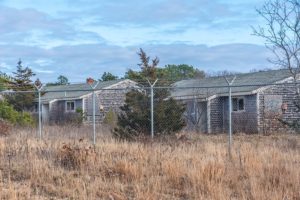TRURO — About half of the abandoned buildings at the former North Truro Air Force Base will be razed by 2024 thanks to an $8-million grant to demolish derelict structures in the Cape Cod National Seashore.
Seashore officials applied for the funds through the Great American Outdoors Act. They secured $8.338 million to tear down 44 buildings in the Park’s 46,000 acres, said Linzy French, public information officer for the Seashore.

Twenty-five of the buildings are at the former base, now called the Highland Center, a military outpost from 1950 until 1985 that, at its peak, housed some 500 employees and their families. The last 15 asbestos-laden houses in the ghost neighborhood will be destroyed along with 10 other larger structures. The hazardous building materials will be removed, French said. The work is scheduled to be done in 2023 and 2024.
The grant funds come without any restrictions on future use of the land under the soon-to-be razed properties, French said. That is hopeful news because local organizations have slowly been creating partnerships with the Seashore to use the 110-acre Highland Center.

Payomet Performing Arts Center already produces performances in a circus tent on the property. And Brian Carlstrom, the current Seashore superintendent, told the Cape Cod Times in 2018 that “the Seashore is interested in looking into public, private partnership possibilities for the Highlands Center area that could include seasonal housing.”
The Seashore owns 300 buildings, French said. That includes more than 100 houses that were acquired in the 1970s from people who built on park land after Congress created a building deadline in 1959 that preceded the establishment of the National Seashore on Aug. 7, 1961.

Homeowners in that situation were given life tenancy or 25-year lease agreements, most of which expired in the 1990s. Some were extended, while four homes with architectural and historic significance have been saved and restored by the Cape Cod Modern House Trust, a nonprofit that entered into a 20-year renewable lease agreement with the Seashore.
Some of the buildings in the Park became staff housing. Six are rented out seasonally as vacation properties by the federal government, French said. And many others are rotting away.
“We acquired these homes and, at some point, maybe there was a plan to maintain them,” French told the Independent.

But the Park Service’s infrastructure needs far exceed the amount of money available to keep everything in working condition, she said. The Seashore manages 80 historic structures and a whole lot more, French said.
“At this point, the homes have become a maintenance burden and an eyesore,” she said. “The whole reason the Great American Outdoors Act was created is because the National Park Service has a maintenance backlog.”
Besides those at the former North Truro Air Force Base, the properties slated to be demolished include three MITRE Corp. buildings off Collins Road in Truro that were part of a U.S. Dept. of Defense radar system set up in the 1950s as an early warning system should Soviet planes attack the Eastern Seaboard.

Among the 16 other houses to be torn down are two on Snake Creek Road in Wellfleet’s Herring River floodplain that were acquired by the Park Service to facilitate the Herring River Restoration Project. One, owned by Gerald and Hila Feil, was sold to the Seashore in 2017 for $310,000. The other, owned by Wellfleet Recreation Dept. Director Rebecca Rosenberg, was acquired by the Park in 2019 in an exchange that allowed Rosenberg to buy a house in the Seashore on Long Pond for $75,000. That exchange required an act of Congress.
Three houses to be removed are in Eastham along the Nauset Inlet. The rest are dotted around Newcomb Hollow Beach, Ocean View Drive, and the kettle ponds of Wellfleet. French said the Seashore will not list the addresses so as not to attract vandals. The ones that are in the worst shape will be demolished first, she said.
Peter McMahon, founding director of the Cape Cod Modern House Trust, said none of the structures marked on the Seashore’s map appear to have historic significance, though without addresses he cannot be positive. The Seashore’s press release called them all “nonhistoric.”



